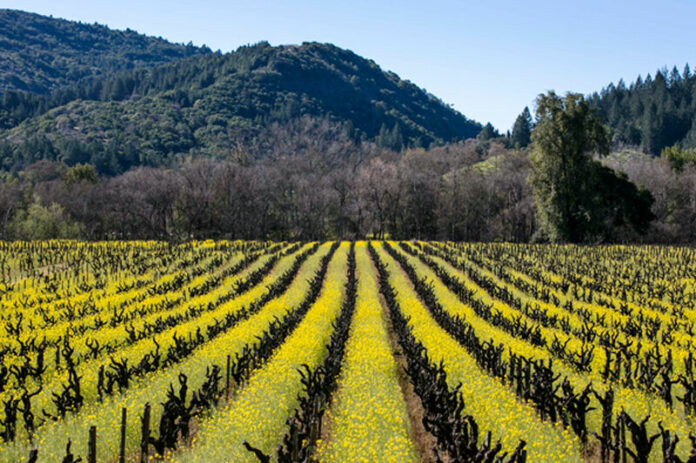Sonoma County’s largest industry and world-class calling card last year was greatly impacted by the dual calamities of more wildfires and the continuing COVID-19 pandemic. Where “sip” used to be something you did with a glass of premium Sonoma County wine, in 2020 “SIP” also stood for shelter in place.
On Thursday, Jan. 14, Sonoma County Winegrowers hosted a virtual version of its annual Dollars & Sense seminar and tradeshow, featuring experts on the global wine market, sustainable farming innovations, grape growers’ community leadership efforts and a few year-end awards and cautious looks forward to 2021. Congressman Mike Thompson also shared some pre-recorded comments from his Washington, D.C. office, recorded before the violence under the Capitol dome on Jan. 6.
Speakers shared a general consensus that 2021 will be very different from 2020, but at least one presenter admitted there will be “as many unknowns as there will be knowns.” The 2020 local grape crop was greatly impacted by wildfire and smoke that occurred during the height of harvest activity, impacting as many as 70% of the Winegrowers’ 1,600 grower members with losses totaling 50,000 tons of unpicked or wasted fruit. Early estimates of the 2020 crop tonnage stands at 160,000 tons, down significantly from a 2019 total of almost 280,000 tons.
There was a faint silver lining to the low crop tonnage because 2020 began with an over supply of bulk wine in tanks where the lighter crop has now brought the grape market more in balance with shifting demand and consumer patterns. Finished wine sales moved to more e-commerce as restaurants closed and consumers stayed home and did more cooking and wine drinking.
“Wine is still an affordable luxury,” said Peggy Gsell, a market analysis for Nielsen. Money that wasn’t spent of sports events and other live venues was redirected to more self-treats of stay-at-home wine and other beverage consumption, she said. Even so, the total wine sales market increases were “minimal to flat,” she also reported.
Several speakers noted how the wine consumer population is shifting away from Baby Boomers to a younger Generation X population, which also favors ciders, spritzers and wine in cans.
Keynote speaker Ray Isle, executive editor of Food & Wine magazine, declared 2020 a “very crazy year, with industry tariffs, COVID-19 pandemic, social justice protests, wildfires in all regions of California, climate change and election craziness.”
He said the wine industry was changed with restaurant closures and loss of winery-hosted wine tastings and sales.
“We want to retire the word ‘pivot’ in 2021, but that is what all of us were doing and some of the changes to more on-line sales and virtual tasting events may become permanent,” he said.
Isle predicted that tourism will rebound after the COVID-19 pandemic, but he couldn’t say when. “I do think, no matter what, that virtual tastings will stay with us.” Isle said last year he adopted a “WTF strategy,” where he pulled lots of his older wines from his cellar and drank up. “I figured if not now, then when?”
Karissa Kruse, president of the Winegrowers, reviewed the many grower support efforts, farmworker relief programs and continued collective work of the local farmers to reduce greenhouse gas emissions and implementation of other sustainability farming innovations.
“Like I am always reminded by our members, I say farmers are optimists and I think we are ready to have a great year in 2021,” she said.
Kruse also announced the annual Nick Frey Community Contributors Awards. Honored were a dozen local banking, agricultural industry partners and individuals who made significant money donations to the Winegrowers nonprofit foundation that supported housing, food and other relief for farmworkers and their families. Awardees included Atlas Vineyard Management, Exchange Bank, Tolay Vista Vineyards, American Ag Credit, The Zenith Agribusiness Solutions, Hal Hinkle Charitable Foundation, Judy Jordan, Rodney Strong Vineyards, Ag Health Benefits Alliance, Peterson Tractors, Sonoma Clean Power, George Peterson Insurance and Dutton Ranch.
Besides the impact of the wildfires on 2020 crop totals and the daily risk to farmworker crews during the coronavirus pandemic, Winegrower board chair Glenn Proctor said the other big news from 2020 was the corrected imbalance of supply and demand for grapes and bulk wine.
“We definitely shifted from an over-supply to a more normal market. I wouldn’t say it’s balanced, but it’s much better for both buyers and sellers,” Proctor said.
Many local growers scrambled through the end of the 202 harvest in September as wildfire smoke threatened and tainted winegrapes. Some growers opted to leave their fruit unpicked and file crop insurance claims. Others risked the spot market and took lower prices than in recent years.
“The pricing has a tight ceiling,” said Proctor. “Growers and buyers should get creative and work out deals that can work for both parties. We all got bruised last year and I’m afraid we’re going to see more wildfires in the years ahead. I’m pretty sure about that.”
59.6
F
Healdsburg
April 18, 2025








